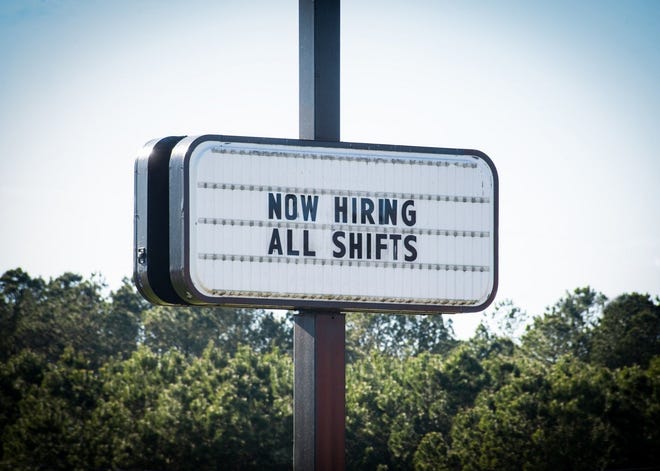Hiring slowed sharply in August however remained sturdy as employers added 315,000 jobs regardless of softer consumer spending positive features, rising costs of curiosity and a sputtering financial system.
The unemployment price rose from three.5% to three.7%, the Labor division mentioned Friday. that is as a consequence of the labor drive — the quantity of people working and wanting out for jobs — shot up by almost 800,000, with a lot of these on the sidelines streaming proper into a constructive labor market.
Economists surveyed by Bloomberg had estimated that 300,000 jobs had been added final month.
Job positive features for June and July had been revised down by a full 107,000, painting a considerably much less booming picture of the labor market than beforehand believed. The change for July was small, nonetheless leaving that month with a blockbuster 526,000 additions. however the revision means the financial system recovered all 22 million jobs misplaced inside the pandemic in August pretty than July as initially thought.
“The job market we see in the present day can’t maintain defying gravity and is falling again to Earth,” says Daniel Zhao, senior economist at Glassdoor, a quantity one job web site.
Jackson hole speech:Jerome Powell hints at extra aggressive Fed price hikes to restore inflation
Housing market replace:Is the US housing market in a recession or a correction?
What discipline has the very best job development?
expert and enterprise companies led the August advances with sixty eight,000. Healthcare added forty eight,000 jobs; retail, forty 4,000; and manufacturing, 22,000.
Leisure and hospitality, which incorporates eating places and bars, the sector hit hardest by the pandemic, added a comparatively modest 31,000 jobs after averaging ninety,000 the primary seven months of the 12 months. The sector, which has been struggling to search out enough workers, stays 1.2 million jobs wanting its pre-COVID stage.
One encouraging signal: The portion of yankee residents working or wanting for jobs jumped from sixty two.1% to sixty two.4%, matching the latest peak in March however nonetheless properly under the pre-pandemic stage of sixty three.4%.
a mannequin new gender hole:males recovered all jobs misplaced by the pandemic. women have not.
That share had been rising as workers returned to a scorching labor market after caring for youngsters or staying idle as a consequence of of COVID-19 fears. however it broadly edged down in latest months, suggesting widespread labor shortages might persist and push pay will enhance greater. That seemingly would further gasoline inflation that’s shut to a forty-12 months extreme.
In August, common hourly earnings rose 10 cents, conserving the annual enhance unchanged at a nonetheless-hefty 5.2%.
Slowing job development and the massive rise inside the labor drive might assist reasonable inflation and lead the Federal Reserve to increase its key price of curiosity by half a proportion level this month rather than a third straight three-quarters level hike, says economist Michael Pearce of Capital Economics.
In an interview, Labor Secretary Marty Walsh famous the labor drive participation price for prime-age workers (25 to fifty 4) is now simply underneath its pre-pandemic stage at eighty two.eight%. the pace for women in that age group, at seventy seven.2%, shot previous its pre-COVID mark final month.
“We’re getting individuals again to work,” Walsh mentioned.
He partly credited the better availability of little one care workers and companies as properly as to firms’ elevated willingness to permit workers to work remotely, a minimal of a pair of of the time.
How does the roles report have an effect on the inventory market?
Markets open greater Friday with the Dow Jones Industrial common rising a hundred thirty factors, or zero.4%, as of 10 a.m. EST. The S&P 500 was additionally up zero.4%.
Why is it so onerous to lease proper now?
Many specialists reckoned August lastly would mark the start of a pullback in payroll development now that the U.S. has recouped all of the roles misplaced inside the pandemic. to this point this 12 months, the labor market has averaged 438,000 month-to-month payroll positive features, shrugging off a shrinking financial system, hovering inflation, and mounting recession fears.
Persistent labor shortages have made many firms reluctant to diminish staffers and even inspired some firms to convey on workers they don’t want inside the current wobbly financial system with an eye mounted in the direction of an eventual rebound.
and a few industries, like eating places and bars, are nonetheless properly under their pre-COVID employment ranges and struggling to catch up as individuals resume eating out, touring and completely different actions in greater numbers. For now, the strong job numbers imply extra household earnings and spending, insulating the financial system from a recession, a minimal of inside the quick time period.
Tom Bemiller, CEO of the Aureus Group, which owns three auto physique retailers inside the Philadelphia suburbs, has seen gross sales surge as a consequence of the second half of final 12 months as individuals started driving extra after reducing again early inside the pandemic.
He has employed three technicians to this point this 12 months and plans so as to add 5 extra. however, he says, “It’s very difficult. It’s unusual that somebody responds to a job advert.”

The labor scarcity “has required us to make modifications to the enterprise mannequin,” Bemiller provides.
He has started bringing on some mechanically-inclined workers with no auto physique expertise as apprentices. till they’re expert, they carry out much less difficult duties, like dismantling elements on damaged automobiles whereas extra expert technicians do repairs, he says.
whereas the labor market stays sturdy, most workers who had been laid off in spring 2020 have been rehired, leaving much less residence for outsize employment positive features inside the months forward. additionally, aggressive Federal Reserve price of curiosity hikes to battle inflation have been anticipated to finally dampen enterprise hiring and funding.
Moody’s Analytics predicts payroll advances will gradual to about a hundred,000 a month by the extreme of the 12 months. Some economists are forecasting a recession by the center of 2023.
Contributing: Elisabeth Buchwald

Moody’s Analytics predicts payroll advances will gradual to about a hundred,000 a month by the extreme of the 12 months. Some economists are forecasting a recession by the center of 2023.



0 Comments